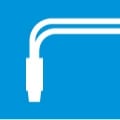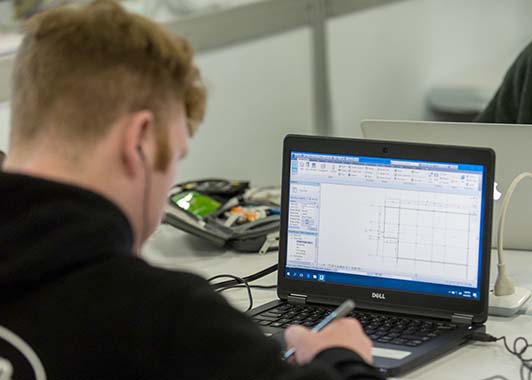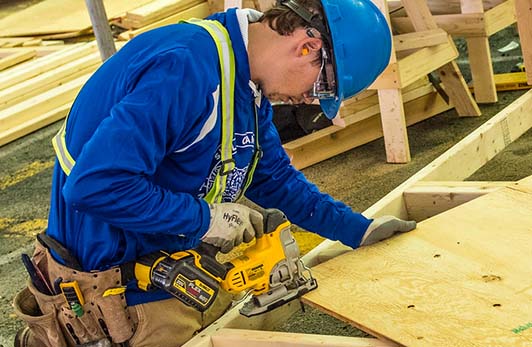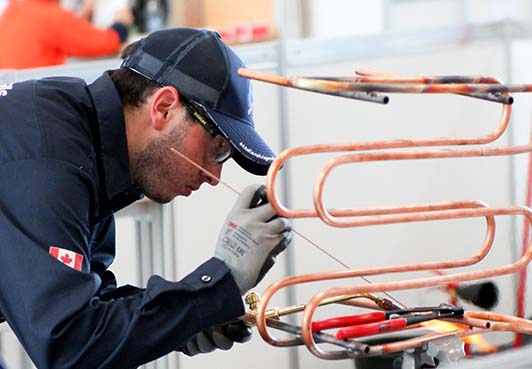Welding
What is welding?
Welding involves the joining of metals using manual, semi-automatic and automatic arc welding equipment. Welders generally plan their work from drawings and blueprints and may use hand tools and machines to fabricate, assemble and welding to make products. Manual welding is controlled entirely by the welder, while semi-manual welding uses machines to perform some of the tasks.
There are many different types of welding depending on the material, equipment and techniques used, the nature of the final product and the degree of expertise required. These categories include Arc welders, Mig welders, TIG welders, Pressure welders, Fitter-Welders and flame-cutters. Welding provides a lucrative and rewarding career, with highly transferable skills and can offer very diverse work and challenges.
Welders perform some or all of the following duties:
- Read and interpret blueprints or welding process specifications
- Operate manual or semi-automatic welding equipment to fuse metal segments using processes such as gas tungsten arc welding (GTAW), gas metal arc welding (GMAW), flux-cored arc welding (FCAW), plasma arc welding (PAW), shielded metal arc welding (SMAW), oxy-acetylene welding (OAW), resistance welding and submerged arc welding (SAW)
- Operate manual or semi-automatic flame-cutting equipment
- Operate brazing and soldering equipment
- Operate metal shaping machines such as brakes, shears and other metal straightening and bending machines
- Repair worn parts of metal products by welding on extra layers.
- Operate previously set up welding machines such as spot, butt and seam resistance or gas and arc welding machines to fabricate or repair metal parts
- Operate previously set up brazing or soldering machines to bond metal parts or to fill holes, indentations and seams of metal articles with solder
- Start up, shut down, adjust and monitor robotic welding production line
- Assist with the maintenance and repair of welding, brazing and soldering equipment
- May adjust welding heads and tooling according to work specifications.
HOW TO JOIN THE FIELD
Completion of secondary school is usually required.
Completion of a three-year apprenticeship program or A combination of over three years of work experience in the trade and some college or industry courses in welding is usually required to be eligible for trade certification.
Trade certification is compulsory in Alberta and available, but voluntary, in Newfoundland and Labrador, Prince Edward Island, Nova Scotia, New Brunswick, Manitoba, Saskatchewan, British Columbia, Nunavut, the Northwest Territories and the Yukon.
Interprovincial trade certification (Red Seal) is also available to qualified welders.
Welding, brazing and soldering machine operators
Some secondary school education is required.
Several months of on-the-job training are usually provided.
Experience as a machine operator helper may be required.
Experience with robotics may be required.
INDIGENOUS AND REMOTE CONSIDERATIONS
Positions in welding may not be abundant in Indigenous and remote communities. However, if there are nearby mining operations, candidates may be able to get hired to travel in. Many mines operate on a 2-week in, 2-week out work rotation.
With math literacy in the north being lower than in other places, northern and remote students may need extra support in order to pass tests and get their red seal.
DISABILITY CONSIDERATIONS
With this job being heavy manual labour, it may not be possible for someone with a severe physical disability. Accommodations may be necessary for someone with a learning disability.
Find the right career path for you with our interactive map!
Trouvez le cheminement de carrière qui vous convient grâce à notre carte interactive!
Sample Job Titles
- Blacksmith
- Millwright
- Boilermaker
- Aviation welding technician
- Brazing machine operator
- Arc Welder
- Spot welder
Companies and Sectors
- Construction industry
- Manufacturing industry
- Auto body shops
- Underwater welders
- Mining
- Aviation

Welding and the Skills for Success Program
The key Skills for Success for this career path are:
- Reading
- Numeracy
- Adaptability



